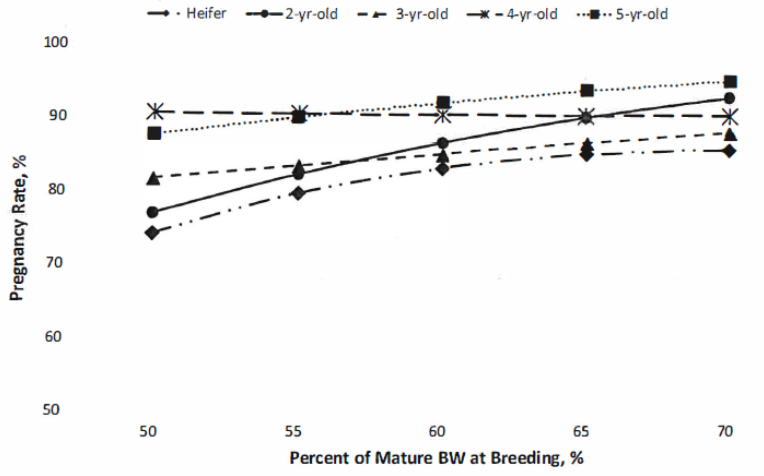Effect of Heifer Percent Mature Body Weight at Breeding on Heifer Performance, Calf Production, and Subsequent Pregnancy Rates
Monday, January 1, 2024
Management of beef replacement heifers from weaning to breeding is critical to their lifetime productivity. Traditional recommendations suggest that replacement heifers should be at 60 to 65% of her mature body weight (BW) at the time of breeding to obtain optimal production efficiency and achieve the greatest pregnancy rates.1 This practice was based on research conducted during the late 1960s through the early 1980s. However, more recent research has shown that feeding beef heifers to 50 to 55% of mature BW reduced body size and development costs without compromising pregnancy rate.2, 3
University of Nebraska researchers conducted a study to determine the impact of differing percentages of heifer mature BW at breeding on reproductive performance and calf production. 4 This was a retrospective study using data collected from Red Angus x Simmental crossbred cows and heifers (1,434 head) near Whitman, NE at the University of Nebraska, Gudmundsen Sandhills Laboratory from 2005 through 2019. Data were collected from both March- and May-calving herds and heifer BW was collected at the time of breeding. Heifer weight expressed as a percentage of mature body weight at breeding was used to conduct a regression analysis from 50 to 70% of mature BW to determine the impact of body weight at breeding on reproductive performance.
The impact of percent of mature BW at breeding in replacement heifers on subsequent pregnancy rates as a heifer, 2-, 3-,4- and 5-year-old are shown in Figure 1. Initial pregnancy rates of heifers that were 60, 65, and 70% (83, 85, and 85%, respectively) of mature BW at the time of breeding were increased (P < 0.001) compared to heifers at 50 and 55% (74 and 80%, respectively) of mature BW. Furthermore, pregnancy rates as 2-year-olds were increased (P < 0.001) for heifers that were 60, 65, and 70% of mature BW at breeding, with respective pregnancy rates from 50 to 70% being 75, 82, 87, 90, and 92%. However, mature-BW percentage at breeding did not influence (P ≥ 0.15) pregnancy rates as 3-, 4-, and 5-year-old cows.
These researchers also reported that as heifer percentage of mature body weight at
breeding increased, first calf birth weight and weaning weight increased. With every
5% increase in percentage of mature BW at the time of breeding, first calf birth weights
increased by 1.2 lb (P < 0.001). At the time of weaning, as heifer mature BW percent
increased 5%, calf weaning weights increased 5 lb (P = 0.007). A greater percentage
of heifers at a mature body weight of 50, 55, and 60% at breeding calved during the
first 21 days of the calving season than 65 and 70%.
These authors concluded that “these results suggest that developing heifers at 60-70% of mature body weight at the time of breeding will likely have increased heifer pregnancy rates and as a 2-year-old. However, heifers below 60% of mature body weight at the time of breeding will likely have a higher percentage calve earlier in the first calving season, but calf weaning weights will not be increased. Although input costs would likely be reduced, the greatest challenge with developing heifers below 60% of mature body weight is rebreeding as 2-year-olds, however, there is no impact on subsequent pregnancy rates after 2-years of age."
Figure 1. The impact of percent of mature BW at breeding in replacement heifers on
subsequent pregnancy rates as a heifer, 2-, 3-,4- and 5-year-old. Where yearling heifers
is represented by a dashed and dotted line with diamonds (P < 0.001), 2 year-old a
solid line with circles (P < 0.001), 3-year-old a dashed line with triangles (P =
0.19), 4-year-old a dotted line with squares (P = 0.85), and a 5-year-old a long-dashed
line with stars (P = 0.15).
1 Funston, R. N., J. L. Martin, D. M. Larson, and A. J. Roberts. 2012. PHYSIOLOGY AND ENDOCRINOLOGY SYMPOSIUM: Nutritional aspects of developing replacement heifers. J. Anim. Sci. 90:1166-1171.
2 Lardner, H. A., D. Damiran, S. Hendrick, K. Larson, and R. Funston. 2014. Effect of development system on growth and reproductive performance of beef heifers. J. Anim. Sci. 92: 3116-3126.
3 Mousel, E. M., R. A. Cushman, G. A. Perry, and L. K. Kill. 2012. Effect of Heifer Calving Date on Longevity and Lifetime Productivity. In: Proceedings, Applied Reproductive Strategies in Beef Cattle. p 23-31.
4 Crouch, J.N., J. T. Mulliniks, Musgrave, J.A., Hanford, K.J., and McCarthy, K.L. 2024. Effect of Heifer Percent Mature Body Weight at Breeding on Heifer Performance, Calf Production, and Subsequent Pregnancy Rates. Nebraska Beef Cattle Report MP118:10-12.
Oklahoma State University, as an equal opportunity employer, complies with all applicable federal and state laws regarding non-discrimination. Oklahoma State University is committed to a policy of equal opportunity for all individuals and does not discriminate based on race, religion, age, sex, color, national origin, marital status, disability, or veteran status with regard to employment, educational programs and activities, and/or admissions. For more information, visit the university's Equal Opportunity website.

